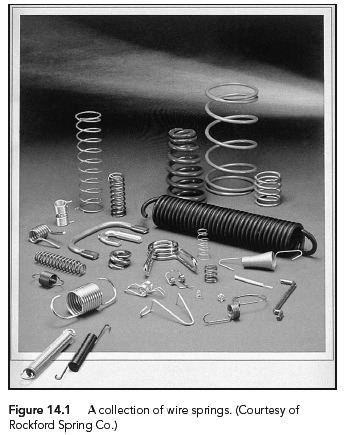 <a onClick="window.open('/olcweb/cgi/pluginpop.cgi?it=jpg:: ::/sites/dl/free/007242155x/69909/chap14intro_figure1.jpg','popWin', 'width=400,height=505,resizable,scrollbars');" href="#"><img valign="absmiddle" height="16" width="16" border="0" src="/olcweb/styles/shared/linkicons/image.gif"> (52.0K)</a> <a onClick="window.open('/olcweb/cgi/pluginpop.cgi?it=jpg:: ::/sites/dl/free/007242155x/69909/chap14intro_figure1.jpg','popWin', 'width=400,height=505,resizable,scrollbars');" href="#"><img valign="absmiddle" height="16" width="16" border="0" src="/olcweb/styles/shared/linkicons/image.gif"> (52.0K)</a> | |
Springs are used to exert forces or torques in a mechanism or primarily to store the
energy of impact loads. These flexible members often operate with high values for the
ultimate stresses and with varying loads. Helical springs are round or rectangular wire,
and flat springs (cantilever or simply supported beams) are in widespread usage. Springs
come in a number of other kinds, such as disk, ring, spiral, and torsion bar springs.
Numerous standard spring configurations are available as stock catalog items from spring
manufacturers. Figure 14.1 shows various compression, tension, and torsion springs. The
designer must understand and appropriately apply spring theory to specify or design a
component.
Pneumatic springs of diverse types take advantage of the elastic compressibility of
gases, as compressed air in automotive air shock absorbers. For applications involving very
large forces with small displacements, hydraulic springs have proven very effective. Our
concern in this text is only with springs of common geometric form made of solid metal or
rubber. For more information on others, see [1-5]. As discussed in Section 1.4, mechanical
components are usually designed on the basis of strength. Generally, displacement is of
minor significance. Often deflection is checked whether it is reasonable. However, in the
design of springs, displacement is as important as strength. Anotable deflection is essential
to most spring applications. |

